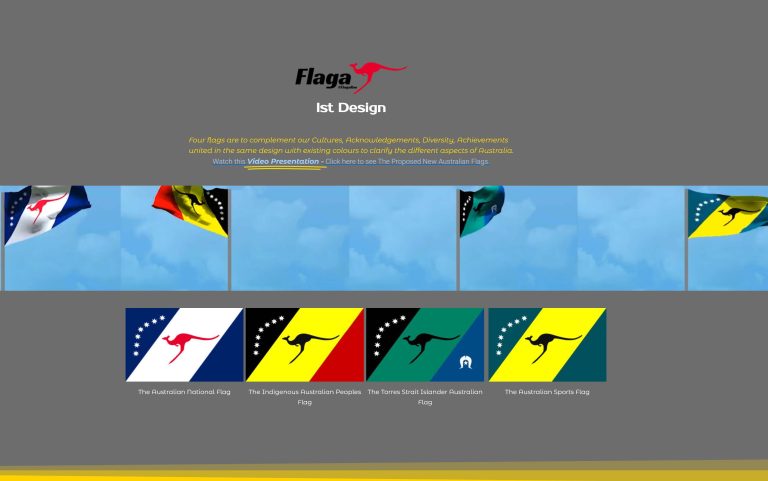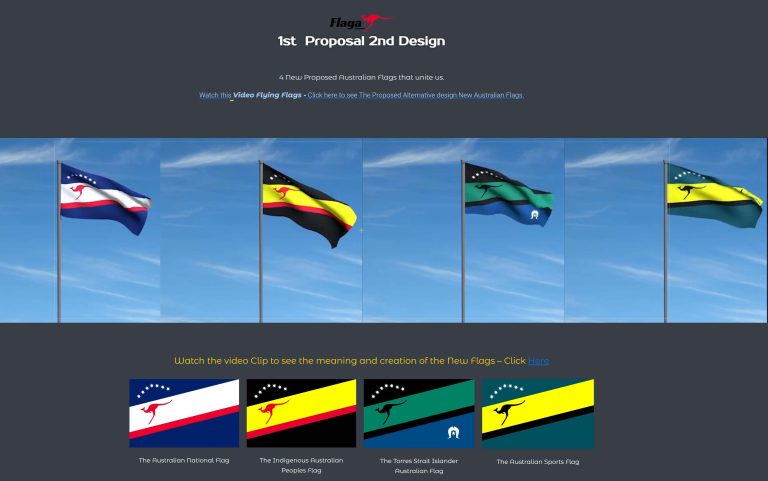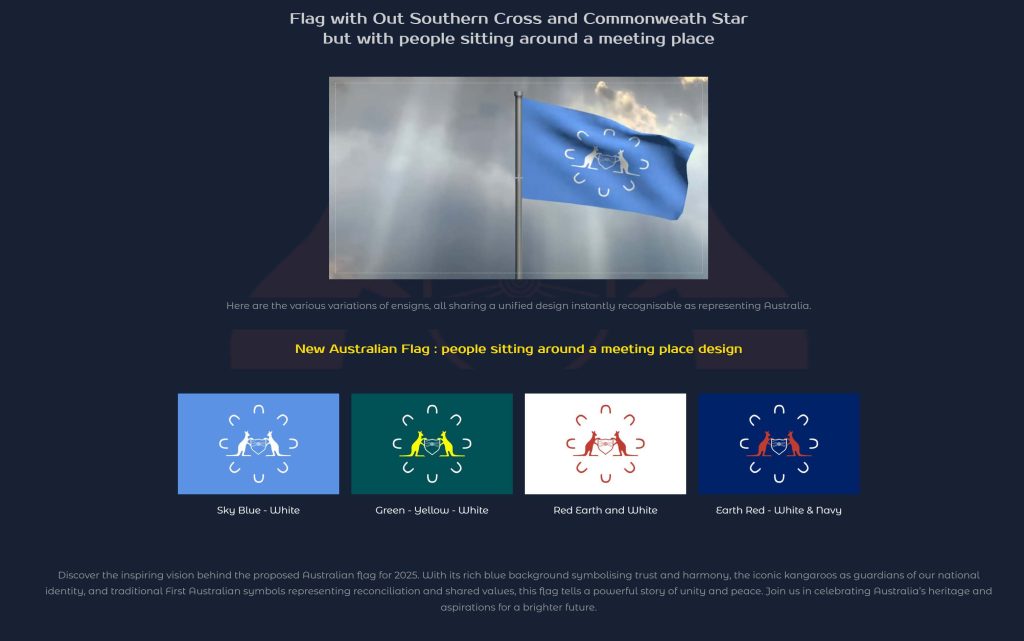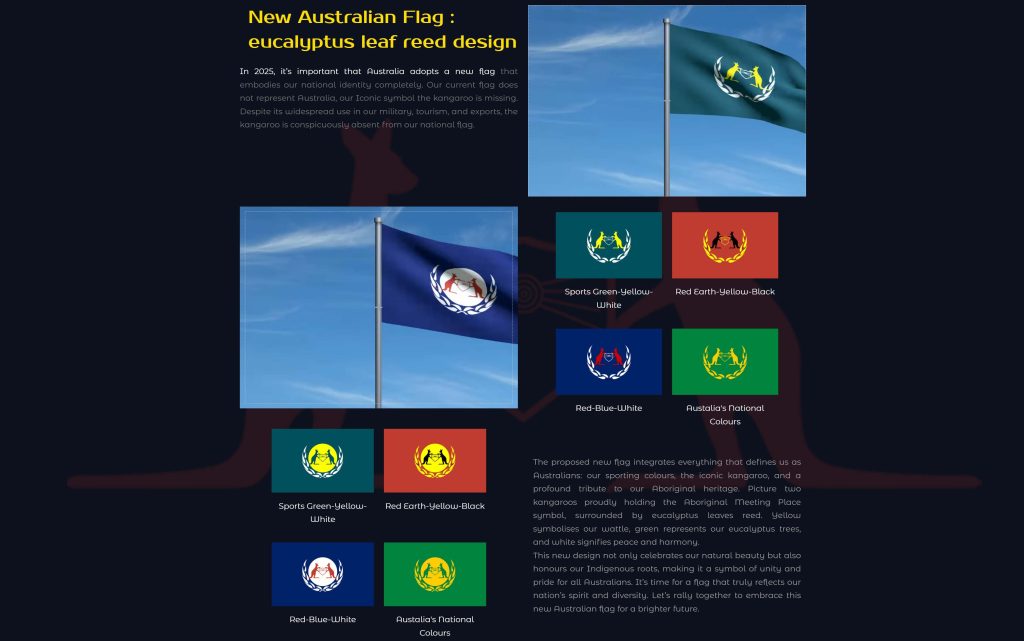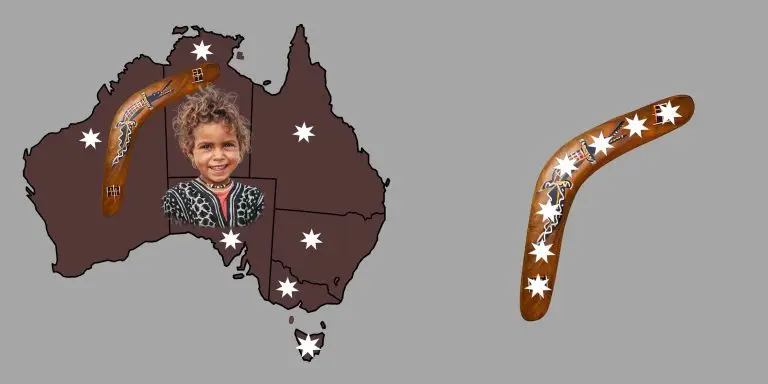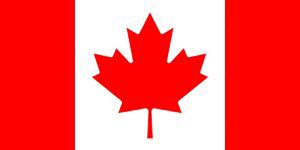New Australian Flag
Australia’s current flag has served us for generations, but the new Australian proposed flag offers a design that better reflects our shared values and diverse heritage.





Why This Flag Matters
Australia deserves a flag that reflects who we are today — inclusive, unified, and forward-looking. This design honours our heritage while embracing our shared future. It’s time for a symbol that every Australian can stand behind with pride.
See more new Australian flag designs below
click to explore
New Australian Flag
New Australian Flag for all Australians Designed by Australianflags.au
Australia’s current flag has served us for generations, but the new Australian proposed flag offers a design that better reflects our shared values and diverse heritage.
A Flag That Unites All Australians
Family design Symbolism of the New Australian Flag
Red — the colour of our soil, grounding us in the land.
Black — honouring our First Australians and their legacy.
White — representing peace at home and abroad.
Southern Cross — Australia’s location in the world.
Seven-pointed star — six points for the states, one for all territories.
Three kangaroos — symbolising the Australian family, united in harmony.
A Call for a New Australian Flag: A True Symbol of Australian Identity
Fellow Australians, it’s time for us to take a step forward and redefine how we see ourselves and how the world sees us. Our current national flag, while deeply rooted in our history, does not fully represent the independent, diverse, and unique spirit of modern Australia. It is a relic of colonial ties that no longer align with our identity as a sovereign and multicultural nation.
The Case for Change
At present, there is a noticeable lack of patriotism among Australians when it comes to our national flag. While we proudly display our kangaroo symbol on our products, in tourism campaigns, by our military, and on countless other platforms, our flag—the most important emblem of national identity—still carries the Union Jack, a symbol of another country. This undermines our sense of unity and pride in being distinctly Australian.
Our flag should be a reflection of who we are today, not a reminder of a colonial past that no longer defines us. It’s not about erasing history but about acknowledging our growth as a nation and embracing a future where our symbols truly belong to us.
Why the Kangaroo?
The kangaroo is uniquely Australian. It cannot move backward, symbolising progress and resilience—qualities that epitomise the Australian spirit. Incorporating the kangaroo into our national flag would immediately and unequivocally declare, “This is Australia.” It is a symbol recognised worldwide and cherished at home, representing our culture, our environment, and our identity.
By replacing the Union Jack with a kangaroo, we are not losing the essence of our current flag but enhancing it. The Southern Cross, already a beloved feature, would remain to signify our place in the southern hemisphere and our guiding principles. The addition of the kangaroo would complete the picture, giving us a flag that is undeniably and unapologetically Australian.
A Flag That Inspires Unity and Pride
A new flag would be more than a piece of cloth; it would be a call to action for Australians to embrace their identity with pride. It would unite us, regardless of our backgrounds, as one people under a symbol that belongs solely to us. It would also send a powerful message to the world: Australia is confident, independent, and proud of its unique place on the global stage.
By voting for a new flag, we are not discarding our past; we are honoring it by acknowledging how far we’ve come and where we’re heading. This is a chance to create a symbol that reflects our diversity, celebrates our achievements, and inspires future generations to be proud of being Australian.
A Vote for the Future
The decision to adopt a new flag is not one of division but of unity. It is a chance to break free from the malaise and lukewarm patriotism that stems from a flag that doesn’t resonate with our people. It is an opportunity to declare that we are proud of our identity, our land, and our heritage.
Let’s seize this moment to make history. Let’s vote for a new Australian flag—a flag that speaks to who we are today and inspires pride in all Australians. Together, let’s fly a flag that is entirely, unmistakably, and magnificently Australian.
Why A new Australian Flag
Australia takes pride in its independence, multiculturalism, and distinctive identity. It is important that our flag accurately mirrors these core values.
As a nation that prides itself on Independence, multiculturalism and a unique identity that projects a confident and unique Australian identity to the world. Our flag needs to reflect these values.
The Kangaroo
The kangaroo is a national icon deeply intertwined with Australia’s landscape, culture, and ethos. Globally recognised, it symbolizes the country’s wildlife, resilience, energy, and distinctive character. Its presence on the national flag authentically represents Australia’s spirit and uniqueness to the world.
Strengthening National Unity
A flag acts as a unifying emblem that aims to foster a sense of pride and belonging among its people. As the internationally recognised symbol of Australia, the presence of the National fauna emblem; the kangaroo, on our flag connotes a cohesive Australian pride and patriotism both nationally and internationally.
Reflecting Contemporary Significance
The Australian Defence Force incorporates the kangaroo in its insignias, highlighting its association with bravery, strength, and national defence. National sports including our national rugby league team, AFL and other sports prominently display the kangaroo as their insignia. Qantas also displays the kangaroo on its planes, serving as a recognisable symbol of the country to domestic and overseas audiences. The kangaroo’s widespread use in promoting Australian interests abroad would further its significance as a national emblem.
Symbol of Global Recognition
Symbols hold immense power in conveying a country’s identity and distinguishing it from others. The kangaroo’s global recognition can enhance Australia’s visibility and cultural influence on the world stage. We are unlike any other country (including those with flags remarkably similar to our own).
Acknowledging Indigenous Culture
Moreover, the kangaroo carries cultural significance for Australia’s Indigenous communities, who have lived alongside these animals for millennia. By featuring the kangaroo on the flag, Australia would acknowledge its Indigenous heritage, fostering respect for the oldest surviving human culture on earth and the oldest continent on earth.
The Seven Stars
The kangaroo alongside a boomerang-shaped constellation of seven stars is a testament to Australia’s unity and diversity. The seven stars, each with seven points, represent the six states and one for all territories, symbolising the collective strength and history of Australia. The boomerang shape signifies the enduring presence of Indigenous Australians across all states and territories, acknowledging their deep and caring connection to Country .
Strengthening National Unity
A flag acts as a unifying emblem, fostering a sense of pride and belonging among citizens. The flag design, with its inclusive representation of all states, territories, and Indigenous heritage, promotes a unified Australian identity. By incorporating symbols that resonate with all Australians, the flag encourages a shared sense of pride and belonging across diverse communities.
Reflecting Contemporary Significance
The symbolism behind the seven stars and the boomerang shape acknowledges both the geopolitical structure and the historical and cultural significance of Indigenous Australians across the nation. The arc shape of the stars in the boomerang formation can also symbolise a rainbow with its new beginnings, as well as the iconic Sydney Harbour Bridge, which is an internationally recognised landmark.
Symbol of Global Recognition
Utilising such a distinct design on the national flag would enhance Australia’s visibility and cultural influence globally. The recognisable symbols – the kangaroo, stars representing states and territories, and the boomerang shape – would serve as powerful ambassadors, fostering positive international perceptions and projecting Australia’s unique identity on the world stage.
Acknowledging First People’s Culture
The flag design’s incorporation of the boomerang shape pays homage to Australia’s First People’s heritage . By prominently featuring this element, the flag recognizes and celebrates the rich cultural contributions of First Australians and Torres Strait Islanders, promoting greater respect and understanding of their legacy.
Conclusion
Inclusion of the kangaroo, stars, and boomerang as well as the traditional and historic colour palette presents a compelling case for a new Australian flag that reflects the nation’s modern identity, values, and inclusivity as well as paying homage to our history. This proposed emblem not only acknowledges the Indigenous history deeply reflected in all regions but also symbolises unity, strength, and diversity.
Embracing this redesigned flag would not only honour Australia’s past, present and future, but also represent its contemporary and confident spirit, fostering a stronger sense of national pride and unity among its people while projecting a distinctive and inclusive image to the world.
Australian National Flag
The Flags Act of 1953 made the Blue ensign as the Offical National flag of Australia . Please read the pmc.gov.au for detail information.
I wish to emphasize that my intention is not to stir anger, malice, or distrust among fellow Australians.
I had an idea and wanted to initiate a discussion about our Australian Flags. Introducing an alternative perspective to the discussion table, I present the New Australian Flags Proposal through the www.AustralianFlags.au website.
- How many of us know that we have a seven-pointed Commonwealth Star on our Australian Flag and its meaning.
- Did you know that we have 10 Territories?
- Did you know we had a Red ensign flag that was commonly used from 1901-1953
These are just a few interesting aspects of our flag’s history and design that can be found on the Federal Government’s website
Click on the link
https://www.pmc.gov.au/honours-and-symbols/australian-national-symbols/australian-national-flag.
My aim in sharing this information is to offer a deeper understanding of our national flag, even for those who may not necessarily advocate for a change in our flag. Please visit the website www.australianflags.au to delve into the meaning behind the proposed new Australian Flags.
To the talented Australian Designers among us, I extend an invitation to create a new Australian flag and what it represents.
Canadian National Flag
CANADA compaired with Australia
Canada and Australia indeed share significant historical and institutional similarities. Both nations adopted the parliamentary system, maintain ties to the British monarchy, and use UK English as an official language. However, one notable divergence lies in the evolution of their national flags.
In 1965, Canada adopted a new flag, the iconic maple leaf design, in an effort to assert its distinct identity on the global stage. A decisive step towards defining Canada’s unique national character, setting it apart from its colonial past and embracing a singular emblem that resonated deeply with its citizens.
Conversely, while Australia shares a parallel historical trajectory, its flag has remained relatively unchanged, still bearing symbols tied to its colonial legacy. The discussion about updating the Australian flag to better represent its modern identity has surfaced multiple times but hasn’t seen the same momentum as Canada’s flag transformation.
Canada’s move to embrace a new flag underscores a distinct visual representation, while Australia’s journey in this regard remains unchanged.
https://www.canada.ca/en/canadian-heritage/services/flag-canada-history.html
Questions and Answers

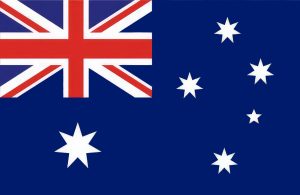
Embracing a change in the Australian flag design presents an opportunity to reflect the country’s evolving identity and values, much like Canada did when they adopted a new flag in 1965. While the current flag holds historical significance, a redesigned flag could capture the contemporary spirit of Australia, representing inclusivity, diversity, and the nation’s forward-looking aspirations. Just as Canada’s change allowed them to forge a distinct national identity while maintaining their ties to the British Commonwealth, an updated Australian flag could symbolize a renewed sense of unity and progress while preserving the country’s historical connections. This shift would not diminish the importance of the current flag but rather acknowledge the dynamic nature of a nation that continues to grow and redefine itself.
The proposed new flag, featuring the kangaroo and boomerang-shaped stars, effectively symbolises Australia’s unique identity. The creation of four new official flags, such as the national flag, the Indigenous flag, the Torres Strait Islander flag, and the sports flag, allows for a diverse yet cohesive representation of Australia.
Respecting the historical significance of the flag and the sacrifices made by our dads and forefathers is paramount. The consideration for a new flag is not meant to diminish their contributions or the importance of the existing flag.
While the current flag holds immense historical value and represents the efforts of those who fought for it, the idea of a new flag is driven by the recognition that a nation, like Australia, is continuously growing and diversifying. The proposed flag seeks to embrace this evolution, past and present.
The intent is not to erase history but to create a flag that reflects the diversity of Australia while acknowledging the sacrifices and achievements of those who came before. It aims to foster a sense of inclusion, where every citizen, regardless of background, can see themselves represented in the national symbol. The proposal is a step toward ensuring that the flag continues to be a source of pride and unity, honouring the legacy of our dads and forefathers in the spirit of modern Australia.

Having four official flags in Australia, each sharing the unique design with the kangaroo and boomerang-shaped stars, fosters unity and inclusivity. While distinct in their colours with their current meanings, the shared design creates a cohesive visual identity, symbolising a diverse nation that embraces the national flag with its historic links, fosters unity and inclusivity, Indigenous heritage, Torres Strait Islander culture, and sportsmanship. This unified design ensures that any flag flown worldwide unmistakably represents Australia and the diverse facets of its identity.
 Incorporating the kangaroo on the Australian flag is crucial for global recognition. The kangaroo is a universally acknowledged symbol of Australia, ensuring that the flag becomes instantly identifiable worldwide. This recognition enhances the country’s global visibility and fosters a strong and distinctive national identity. Excluding the kangaroo would compromise this powerful association and weaken the flag’s ability to resonate internationally.
Incorporating the kangaroo on the Australian flag is crucial for global recognition. The kangaroo is a universally acknowledged symbol of Australia, ensuring that the flag becomes instantly identifiable worldwide. This recognition enhances the country’s global visibility and fosters a strong and distinctive national identity. Excluding the kangaroo would compromise this powerful association and weaken the flag’s ability to resonate internationally.
 The Qantas kangaroo on their planes symbolises a piece of Australia that travels around the world. Adding this new redesigned kangaroo to our flag instantly makes it uniquely Australian. Just as the airline’s kangaroo represents Australia’s spirit of adventure and resilience, our flag could embody those same values. Our flag represents our pride, and its global recognition, speaks volumes about our identity. Imagine the resonance it would create – just as the Qantas kangaroo does for Australia.
The Qantas kangaroo on their planes symbolises a piece of Australia that travels around the world. Adding this new redesigned kangaroo to our flag instantly makes it uniquely Australian. Just as the airline’s kangaroo represents Australia’s spirit of adventure and resilience, our flag could embody those same values. Our flag represents our pride, and its global recognition, speaks volumes about our identity. Imagine the resonance it would create – just as the Qantas kangaroo does for Australia.
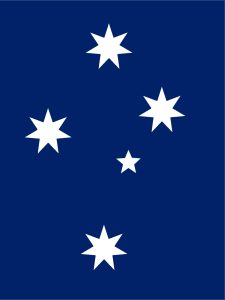
The decision to exclude the Southern Cross stars from the proposed new flags is rooted in a desire to create a unique and distinctly Australian symbol that goes beyond regional associations. While the Southern Cross is shared with other countries in the Southern Hemisphere, the new design aims to forge a national identity centered around Australia’s specific characteristics and heritage.
In the proposed flag, the arrangement of 7 stars holds a symbolic meaning that resonates with the political structure of Australia. The inclusion of 6 stars representing the states and 1 star representing the territories highlights the nation’s political unity. The design also takes inspiration from the shape of a boomerang, an iconic symbol deeply connected to Australia’s Indigenous peoples who have a rich history spanning 60,000 years. Additionally, the boomerang shape pays homage to significant Australian landmarks such as the Sydney Harbour Bridge, further grounding the flag in the nation’s cultural and historical context. This approach aims to create a flag that not only reflects Australia’s political structure but also embodies its diverse cultural and natural heritage in a visually distinctive manner.
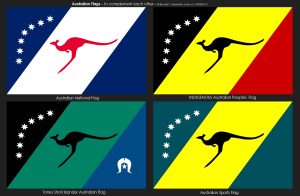
Leaning towards the New 4 Australian Flags Proposal offers several compelling reasons, primarily centered around its simplicity, recognisability, and inclusivity. The design features a simple yet impactful composition, incorporating the iconic Australian kangaroo and the unique arrangement of stars, which is shared among various official flags. Here’s why this proposal stands out:
Simple and Recognisable Design: The proposed flag design is straightforward, consisting of three colors and familiar symbols like the kangaroo and the distinctive star arrangement. This simplicity ensures easy recognition, making it instantly identifiable as uniquely Australian.
Consistency with Official Flags: The inclusion of the same design in various official flags, such as the national flag, Indigenous flag, Torres Strait Islander flag, and the sports flag, fosters a cohesive visual identity. This unity in design reinforces a collective national image while allowing for diversity and representation.
Symbolic Meaning: The star arrangement, representing the states and territories, adds depth and meaning to the flag. This symbolism enhances the flag’s connection to Australia’s political structure, providing a sense of unity and inclusivity.
Cultural Representation: The use of the kangaroo and boomerang-inspired shape not only pays homage to Indigenous culture but also reflects Australia’s unique natural and cultural heritage. This representation serves as a unifying element that resonates with the country’s diverse population.
By leaning towards the New 4 Australian Flags Proposal, Australia ensures a visually distinct and meaningful national symbol that is not only easily recognisable but also reflective of its rich cultural tapestry and inclusive spirit.



